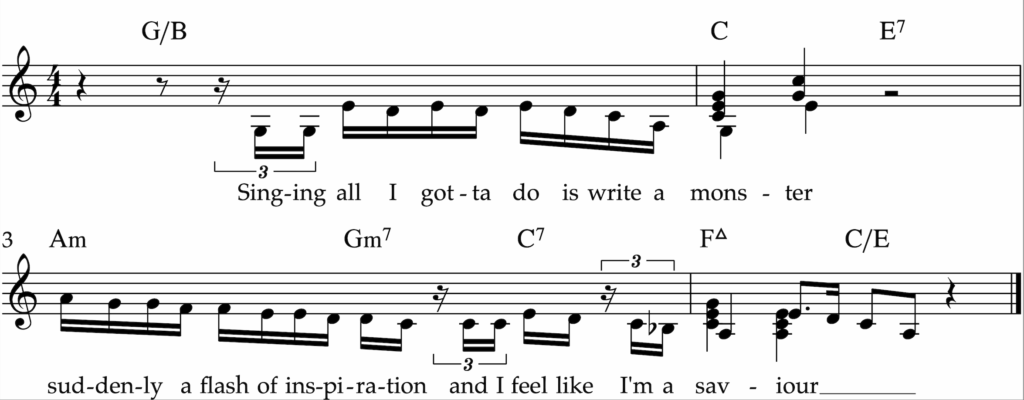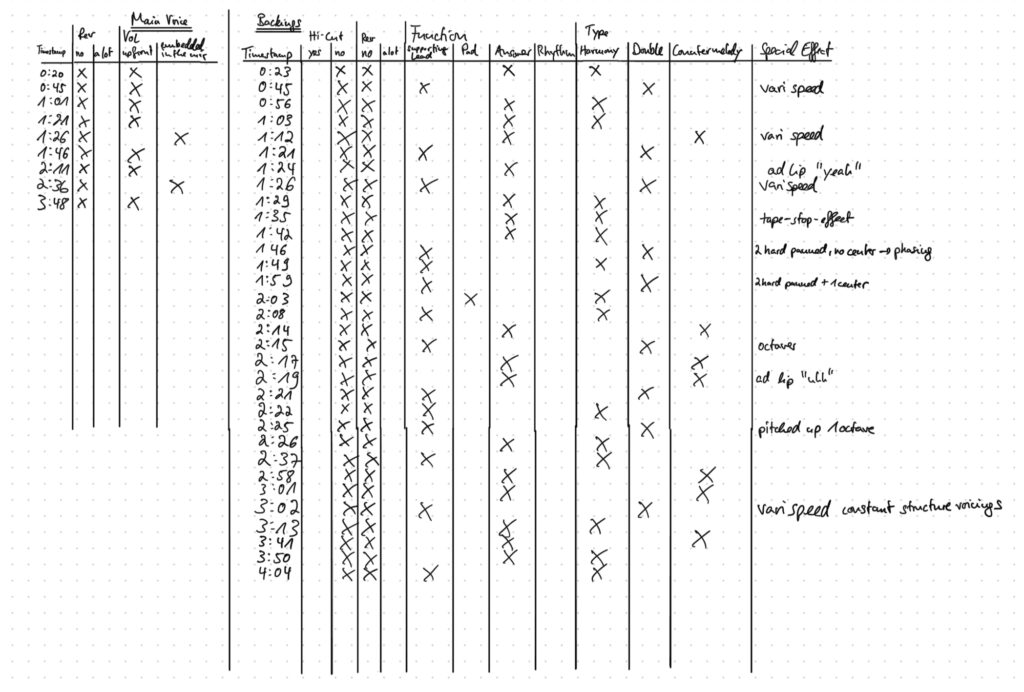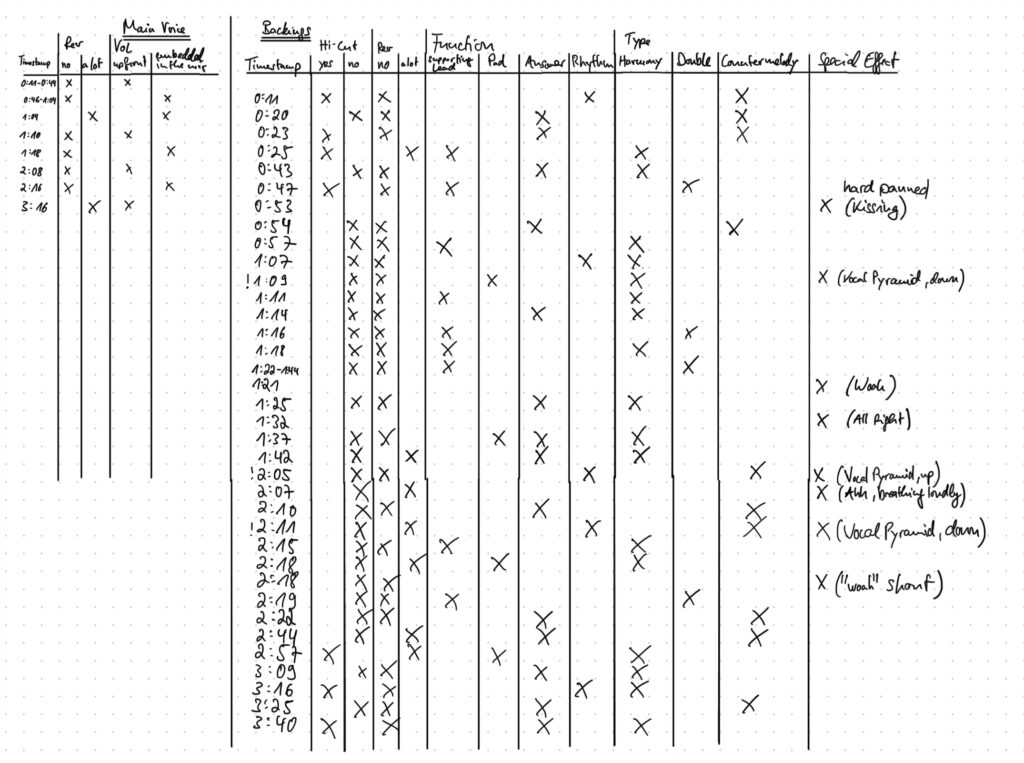In this paragraph I will compare the techniques I found by analyzing the songs „Mankind“, „Monster“, „Time Alone With You“, and „All I Need“ with the main points stated in the interviews by Jesse Passenier and Freddy Tings.
Chronologically, I first analyzed the four songs, then compared them to the interviews and finally extracted nine techniques which I analyzed more in detail.
This page contains from top to bottom:
– comparison analysis with interviews (second step)
– analysis of techniques (third step)
– analysis of the four songs (first step)
Main Voice:
In the Song „Mankind“ by Jamie Cullum the main voice and its effects develop throughout the song but it mostly keeps an intimate quality. Only for the climax towards the end of the song when the arrangement becomes fuller and the energy rises the lead voice gets embedded in the mix.
This corresponds to the general developments in Pop-Jazz stated by Freddy that the vocal should be upfront and loud in the mix but rather natural and also to his statement that effects and strange sounds need to be a confident statement since we have the unnatural and strange gated and side-chained reverb in the first verse of the song which sounds like a Slap-Back Tape-Delay and as a contrast the compressed and dry ASMR-like whispering at the end of the bridge.
„Mankind“ first verse only voice:
„Mankind“ bridge only voice:
This supports the statement that everything has to be authentic and a statement. We do not find any „boring“ sounds in the lead voice but always conscious decisions in the production process.
In the Song „Monster“ the sound of the lead voice is coined by a distortion of the lower frequencies which makes the tone feel warm and energetic almost like being sung through an old microphone.
The distorted sound fits all into the context of the song which starts with a Wurlitzer accompanying the voice.
The general sound of the song embraces the noisy and distorting qualities of analog gear and real human instruments which fits the by Freddy mentioned trend towards retro-vintage sounds.This specific characteristic combined with a certain amount of compression brings out details in the voice which creates a feeling of closeness and adds to the singer’s authenticity.
Example isolated voice:
Jamie Cullum already has a rough and characteristic voice quality and all effects on it are being used in a way that supports what is already there in his tone instead of changing his natural voice color. If the effect of the used techniques also apply to other voices in general respectively my voice in particular will be researches in the chapter „Album“ where I will apply certain techniques to my own music.
In the song „All I Need“ the main voice changes dynamically between being very upfront
and being buried in the mix.
In contrast to that there is except for a few moments no reverb on the voice at all. Jacob Colliers records his voice in a natural way and too much reverb would most likely clash with his thick vocal layers.
In the song „Time alone with you“ the main voice sung by Daniel Caesar is even more extreme regarding the aspect of natural sound of the voice. The relaxed atmosphere of the song asks for a conversational and natural sound which you can clearly hear in the tune.
Only in the choir parts where the main melody is sung by many different layers the lead vocals are not standing out as much.
In comparison to Jamie Cullum Jacob Collier has a dark, smooth and rich voice quality which asks for a natural tone in the production because effects like distortion or saturation could cover his original voice tone which would change it fundamentally and probably be less authentic. He creates thickness and textures rather by stacking his voice and by using vocal techniques than processing it. This is a different approach which preserves his personal vocal color.
Conclusion main vocals:
Both artists have a strong vocal identity and therefore the lead vocal is of special importance to them. This reflects in the placement of the main vocals of both artists in the mix. They both use vocals that feel „close“ and „intimate“ as a way to express their artistic identity and authenticity. Where Jacob Collier has a rather natural vocal sound in his productions Jamie Cullum is working more with tools that bring out certain elements in this voice without „standing in the way“ of sounding authentic.
Still the technique of upfront vocals is not used in a static way but consciously in places that require a strong personal connection to the listener.
Backing vocals:
In the song „Mankind“ the backings are sung by a choir including female voices which contrast the main voice and live above it in the frequency spectrum and therefore open up the sound. As Freddy stated in the Interview the backing vocals only support the main voice as it is common in contemporary music. We find supportive harmonies in the pre-chorus and chorus,
a pad sound and doubled whispering in the bridge.
Isolated voice in the bridge:
The song is not overloaded and backings are effectively being used only in places where they have a powerful impact. This is important since the song itself is quite rhythmical and the essence of it being an intimate, gospel influenced and mostly acoustic production needs enough space to take full effect. This makes sense also in the context of what Freddy says about authenticity in the context of contemporary music when he states that every instrument needs to be heard and decisions have to be made consciously in order to have meaning. For example intimate songs work well in an instrumentation with less instruments and real instruments with little flaws and unperfected sound qualities appear human and more energetic songs benefit from instruments with a rougher sound quality and distortion because they support the intention of the song.
In the song „Monster“ the backing vocals only come in after 0:57 seconds where they act as an echo for the main voice.
Isolated vocals:
In the second verse the vocals function as a dark pad sound matching the atmosphere and the topic of the song. These vocals are a single line but heavily processed and pitched down so the formants get much darker.
Isolated vocals:
Vocals in context of the song:
This is an example of the generally growing love of experimentation with sounds in the scene as mentioned by Freddy Tings. Again the backing vocals function as support for the general atmosphere or like in the following refrain as support for the main voice. Only in the final and dense chorus the backing vocals add a counterline to fill the arrangement.
Isolated Vocals in final chorus:
In the song „All I Need“ Jacob uses mostly natural sounding backings consisting of huge stacks of his own voice and occasionally other artists. He uses his backing vocals very frequently and in all conceivable ways. Dominating is the function of supporting the lead voice (what Freddy mentions as the main function of backing vocals in contemporary Jazz-Pop music).
Isolated voice:
and answering/interacting with it in form of harmonies and counter melodies (both functions and types are mentioned by Jesse as important in modern vocal arrangements) where interaction is used a little less frequently. Naturally there are more places in which supporting a lead voice is appropriate compared to interactive vocals which also thicken the arrangement instead of just the lead voice’s texture.
Very typical for Jacob are creative elements like vocal pyramids, dense, clashing and dissonant voicings and other ad lips and ear candy-like human sounds.
Vocal pyramids:
Kissing sound:
Dissonant Harmonies:

(Transcription by Jason Fieler, Youtube)
In the song „Time Alone With You“ he uses predominantly harmony and doubling to support the lead voice or answer it. Interesting textures are created by heavy processing through varispeed (recording vocals in a different tempo and the speeding it up or slowing it down to match the tempo of the song)or by doubling the lead in octaves. This can be seen in Jacob’s Logic Breakdown session where the explains the technique in detail.
He also uses the stereo image as a tool to create phasing or width within the vocals.
Arrangement backing vocals:
In Jamie Cullum’s songs „Monster“ and „Mankind“ Jesse’s point that the structure in voicing is important was definitely considered when writing the arrangements because the backing vocals are throughout arranged in strong structures.
„Monster“ Vocals + Backings (chorus):

While in Jacob Collier’s productions you find strong structures like doubling or triads which he uses in an unconventional way more as a color in itself than as a normal harmonic filling he paints a lot with dissonance and huge chord stacks

(Transcription by Jason Fieler, Youtube)
which also act more as color and convey movement between different harmonic fields rather than just following the chord changes.
Conclusion backing vocals:
Jamie Cullum tends to use much less backing vocals only in specific places to support the main voice and/or the mood with mostly simple and strong structures sung by female voices whereas Jacob collier uses backing vocals more as a creative tool to paint his songs with thick vocal stacks that are mostly unedited and therefore represent his own vocal color even though he likes to mix it with other vocal stacks from artists he collaborates with. He also includes a lot of dissonance in his arrangements and difficult voicings and scales that represent more sound colors or modes than actual chords. Across both artists you find soundwise either pure and authentic backings or standing out processed weird sounds which is also what Freddy states but the amount of usage is vastly different and while Jamie uses only one type of backing vocals with a particular function at a time in Jacob’s arrangements different types of backing vocals with different functions can overlap and be used simultaneously. The borders between them are fluent. This approach to vocal arranging differs fundamentally from what Freddy and Jesse state is the common way in modern Jazz-Pop territory but it is part of what makes Jacob Collier unique and what he is known for.
Arrangement and production in general:
When looking at the songs „Mankind“, „Monster“, „All I Need“ and „Time Alone With You“ they all seem to follow these principles that were also stated by Freddy in the interview as being part of general recent trends in contemporary music production:
In the arrangement nothing just goes through. There is always a development of sounds and textures within the instruments themselves. They all follow the same sonic trend of sounding warm and retro but at the same time modern and authentic, in Jamie’s case created by working with a lot of distortion and saturation in low frequencies as you can clearly hear in the Wurlitzer sound in the beginning of the song „Monster“. Jacob does it by layering sounds and the use of a barely noticeable details.
The drum sound they use is mostly dry, snare sounds are often layered and only certain snare/clap sounds have some sparse reverb on them. This can be seen in Jacob’s Logic session breakdowns where he shows the isolated drum tracks. The high frequencies are tamed and that creates a loft-like sound that is relaxing to listen to.
The bass has a sub-bass-like quality even in „All I Need“ and „Time Alone With You“ where the bass itself is more lively and active in a funky way compared to Jamie’s more traditional way of assigning the root notes of the harmony to the bass. Still both use a certain amount of bass fills in their songs. This statement is based on my subjective listening experience because the bass is only prominent in places where it plays a fill and on Jacob’s Logic Session breakdown where he shows the isolated bass tracks.
The other instruments have the space they need in order to be hearable but without covering each other.
The clarity and the space in the mix profits from short and controlled dry instrument sounds and consciously shaped reverbs.
Jamie Cullum follows the classic singer-songwriter approach where he bases his production on simple ideas that get embedded in a full mix in a more traditional way meaning that the production follows the core idea of the song. Jacob Collier has a more detailed way of puzzling hundreds of tracks and samples into a universe of soundscapes by layering different sounds and using ear candy in an almost sub-concious way while still preserving the dimension of density flexible in order to keep the transparency to be authentic.
Both artists use the by Freddy mentioned production approach to the extend that every sound and sample gets shaped and controlled to fit the production and the vibe of the song. For example in the song „Mankind“ the drum sound changes from a real drumkit with layered snare samples to an electronic MPC Drum Maschine sound in the end of the bridge and in Jacob Collier’s „All I Need“ the clean funky slap bass Trilian sample changes to a sidechained disco-like synth bass sound in the chorus. This way of music-production would be rather difficult without modern electronically devices and DAWs where powerful computer programs and plugins allow for easy and fast processing of sounds and arranging in a way that would otherwise be impossible to achieve.
Conclusion arrangement and production in general:
Both artists seem to follow the general trends in music production like upfront vocals, dead drums, sub-bass, and layering sounds but the approach to constructing a song differs in a way that Jamie Cullum’s productions are finished songs mostly written at the piano which are then produced and arranged to fit a band context whereas Jacob Collier is working with lots of unexpected electronic and real world sound to create a collage of sounds, instruments, and voices containing a song.
What productions of both artists have in common is that regardless of what the process might be their finished productions contain surprise and movement in the sense that no element is absolutely static.

